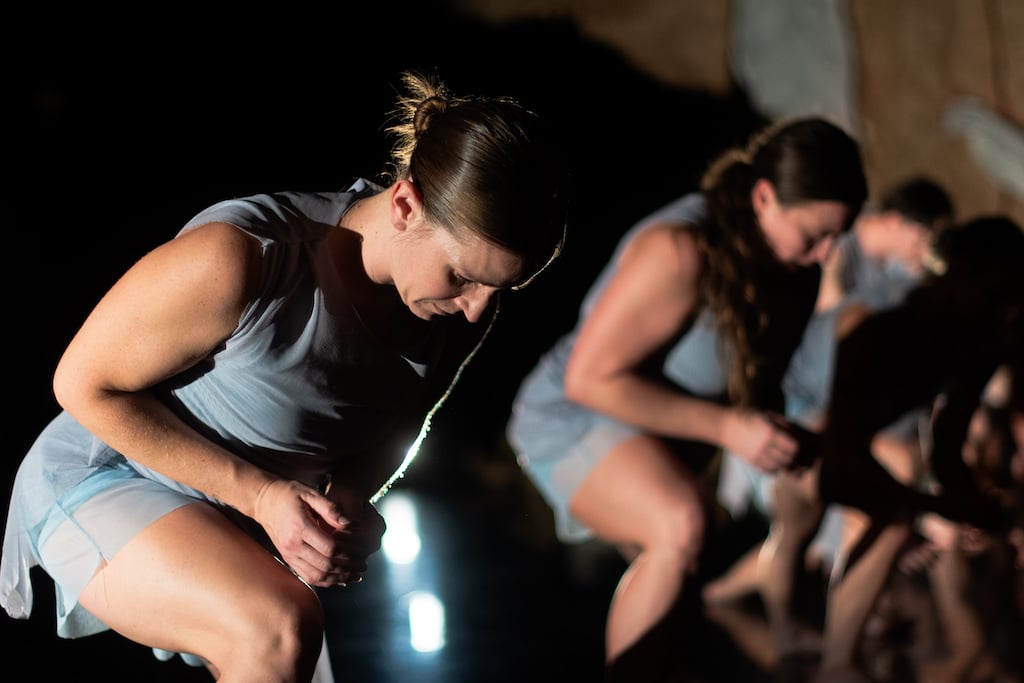Shortly after Vahram Touryan gave an interview about surviving the 1915 Armenian genocide, he began to write what he could remember on a yellow tablet. The ideas flowed easily, wrote Donald E. Miller, co-author of Survivors: An Oral History of the Armenian Genocide. But months later, Touryan was still rewriting, seemingly coming to terms with the atrocities he had witnessed and the loss of family in a violent genocide that claimed the lives of some 1.5 million people.
Stories like Touryan’s were part of the inspirational fabric of ARARAT, choreographer George Staib’s masterful new work for his company staibdance. It premiered last weekend at the Schwartz Center for the Performing Arts’ dance studio at Emory University.

Staib is familiar with politically motivated violence and displacement. An Armenian American, he spent his early childhood in Iran and fled with his family to the United States during Iran’s Islamic Revolution of 1979. Staib has tackled these subjects in previous works, but ARARAT is arguably his strongest and most impactful work to date.
Staib wrote that much has been written about the genocide of 1915, but little has been expressed through contemporary dance performance. This makes ARARAT unique in weaving personal narratives together into a stunning multilayered work of music, text, visual beauty and visceral immediacy.
Together with Gregory Catellier’s scenic and lighting designs, Ben Coleman’s sound score (which Coleman performed on stage alongside the dancers), Milton Cordero’s projections and costumes by Rosalind Staib, Amelia Hayes and Jimmy Joyner, ARARAT was both ethereal and corporeal — ephemeral yet insistent – like a traumatic memory that keeps resurfacing.
Ten strikingly fearless dancers performed and contributed to Staib’s choreography. Influenced by ballet, Humphrey-Limón modern dance and contemporary Gaga and release techniques, it showcased the dancers’ stunning facility. Within smartly conceived groupings and floor patterns, they whipped their limbs through spiral turns and abrupt level changes, wrenching their bodies into tense poses. Fleeting images, abstracted like flashes of memory, shifted between suggestions of abuse and compassion as in a fitful dream.
Seven sections unspooled on a stage where swaths of crinkled paper in brown, black and ivory decked the side walls and grew dense upstage, framing an image of a snow-capped Mount Ararat. When the work began, old sepia photos of Armenian families appeared on set pieces and bodies of dancers who stood or lay motionless on the floor.
Ben Coleman’s atmospheric score suggested waves crashing on the beach, followed by soft tones that ascended and descended a scale like a call from the past or a slow rewind.
Cordero’s images flickered like light reflecting on the wall of a grotto, then morphed into blue and pale gold bursts — perhaps the firing of brain synapses and an invitation into a collective memory.
Pairs of dancers faced each other, clasped wrists and revolved around one another as surrounding luminous images rotated to an immersive effect. Couples’ wrist-grips morphed into gestures and weight-sharing, depicting both violence and support.
To a driving beat, dancers swept into organized chaos — they flung legs in high suspensions, dropped, rolled and sprung into arrested poses. Some grabbed another’s limb then jerked them off balance. They ran in clusters, spun out across the space and fell, as images of birds flew past the mountain behind them.
Text set the tone for the section titled “Chapter One.” Repeatedly, Coleman started to read a literary classic, but, like a glitch in a system, each new start slid into a genocide witness’ story — of forced death marches, starvation, mass abduction and rape, corpses floating down a river — all of which Coleman read in a singsong voice as if reading to children.
Later, the cast crowded onto a makeshift raft. One by one, they dropped into what appeared to be swirling surf. This led to “Thank You For Asking,” a section drawing from transcripts of court martial trials, when perpetrators of the genocide denied that it ever happened.
A square of light on the floor suggested a fighting ring, and dancers moved in and out of the light in a flurry of expressions ranging from joy to play to sexual violence.

Then the lighting shifted and the dancers circled the stage in duets, one partner running freely, arms outstretched like wings, as the other supported from behind. They settled in pairs around the space, gazing into one another’s eyes as they cradled each other’s open hands and bowed their heads until they touched, seemingly united by an appreciation of life in the face of death.
As the piece drew to a close, they lined up against a wall, dropped to the floor and unrolled swaths of paper, scribbling with quick, deliberate strokes. Perhaps, like Touryan, they were revising and rewriting — trying to come to terms with the incomprehensible.
Beautiful, fragmented — at times jarring and at others bewildering — ARARAT is a sobering stunner that confronts genocide and speaks truth to power by acknowledging it and showing us more fully the preciousness of life and the value of new beginnings.
Some want to forget the unthinkable, while others want to deny it. But as Miller wrote: “There is considerable truth in the statement that to deny genocide is to repeat it … Denial of evil is a defense mechanism that a just world simply cannot afford.”
::
Cynthia Bond Perry has covered dance for ArtsATL since the website was founded in 2009. One of the most respected dance writers in the Southeast, she also contributes to Dance Magazine, Dance International and The Atlanta Journal-Constitution. She has an MFA in narrative media writing from the University of Georgia.

